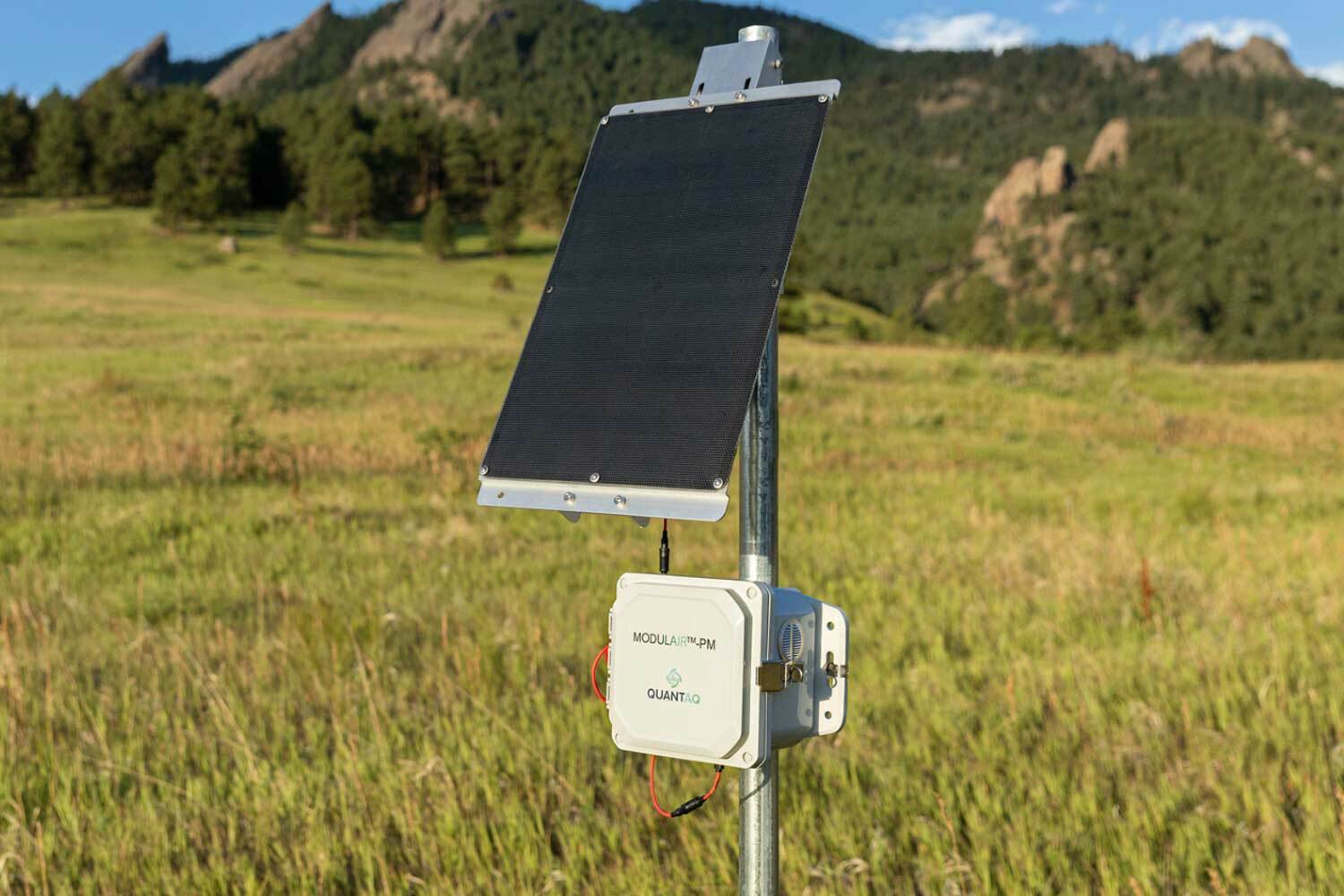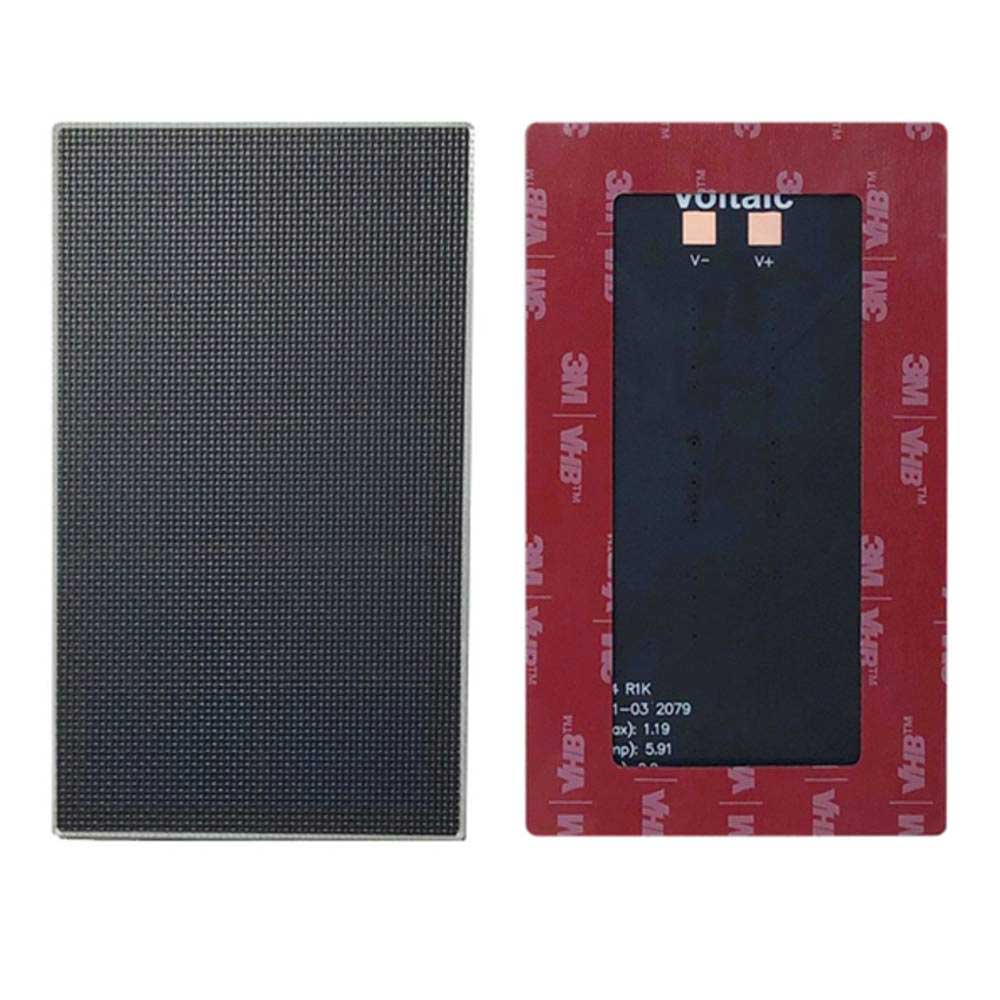__08830.original.jpg)
Read the Arribada Penguin Watch case study.
Voltaic makes small solar panels for outdoor IoT applications.


We think of size both in terms of power and dimensions. Our standard panels for IoT applications produce, at peak, between 0.3 and 17 Watts. Because we use efficient solar cells and frameless designs, our panels are small and light for the amount of power they produce. Our smallest standard panel is 52 x 52mm and the largest is 274 x 393mm.
| SKU | Construction | Voc (V) | Isc (mA) | Vp (V) | Ip (mA) | Wp (Watt) | Cell Efficiency | Dimensions (mm) | Weight (grams) | Mounting | Connectivity |
| P121 | ETFE | 2.8 | 150 | 2.4 | 130 | 0.33 | 22.0% | 52x52 | 8 | VHB (Suggested) | Solder Pads |
| P122 | ETFE | 7.1 | 60 | 6.1 | 60 | 0.33 | 22.0% | 52x52 | 8 | VHB (Suggested) | Solder Pads |
| P123 | ETFE | 7.1 | 120 | 6.1 | 110 | 0.64 | 22.0% | 66x66 | 14 | VHB (Suggested) | Solder Pads |
| P124 | ETFE | 7.1 | 220 | 6.1 | 200 | 1.2 | 22.0% | 66x113 | 32 | VHB (Suggested) | Solder Pads |
| P126 | ETFE | 8.5 | 360 | 7.3 | 330 | 2.3 | 22.0% | 112x136 | 79 | VHB (Suggested) | Wire with 3.5x1.1mm Plug |
| P101 | Urethane | 7.7 | 190 | 6.5 | 200 | 1.3 | 19.5% | 113x89 | 71 | 4 x 4/40 Screw | Wire with 3.5x1.1mm Plug |
| P102 | Urethane | 7.7 | 370 | 6.5 | 350 | 2.3 | 19.1% | 113x112 | 99 | 4 x 4/40 Screw | Wire with 3.5x1.1mm Plug |
| P103 | Urethane | 7.7 | 590 | 6.5 | 560 | 3.6 | 19.1% | 210x113 | 156 | 4 x 4/40 Screw | ScrewWire with 3.5x1.1mm Plug |
| P105 | ETFE Laminate | 7.1 | 990 | 6.1 | 940 | 5.8 | 22.0% | 137x222 | 214 | Through Hole | Wire with 3.5x1.1mm Plug |
| P106 | Urethane | 7.7 | 990 | 6.5 | 940 | 6.1 | 19.1% | 175x221 | 255 | 4 x 4/40 Screw | Wire with 3.5x1.1mm Plug |
| P107 | Urethane | 23 | 510 | 19.51 | 470 | 9.2 | 19.5% | 221x257 | 357 | 4 x 4/40 Screw | Wire with 3.5x1.1mm Plug |
| P108 | ETFE Laminate | 20.45 | 610 | 17.34 | 570 | 9.9 | 19.5% | 223x273.5 | 328 | Through Hole | Wire with 3.5x1.1mm Plug |
| P109 | Urethane | 7.7 | 1520 | 6.5 | 1410 | 9.2 | 19.1% | 221x257 | 357 | 4 x 4/40 Screw | Wire with 3.5x1.1mm Plug |
| P110 | ETFE Laminate | 7.1 | 198 | 6.1 | 188 | 11.5 | 22.0% | 220.5x258.5 | 328 | Through Hole | Wire with 3.5x1.1mm Plug |
| P117 | Urethane | 22.4 | 990 | 18.9 | 930 | 17.6 | 19.1% | 274x393 | 680 | 8 x 4/40 Screw | Wire with 3.5x1.1mm Plug |
| P144 | Glass Laminate | 7.04 | 207 | 5.89 | 185 | 10.9 | 24.0% | 113x66 | 32 | VHB (Suggested) | Solder Pads |
| P150 | Glass Laminate | 20.76 | 3080 | 17.6 | 3210 | 56 | 22.8% | 586x507 | 3400 | Z-clamps | MC4 Connectors |
| P151 | Glass Laminate | 20.6 | 6750 | 17.6 | 6420 | 113 | 22.8% | 980x586 | 6800 | Z-clamps | MC4 Connectors |
| P152 | Glass Laminate | 20.6 | 1690 | 17.6 | 1610 | 28 | 22.8% | 507x307 | 2000 | Z-clamps | MC4 Connectors |
We also manufacture custom solar panels that are significantly smaller and larger than these sizes.
^back to topIt varies based on the size of the panel, location, panel angle, panel azimuth, time of year, and weather conditions. We use the JRC Photovoltaic Geographic Information System to estimate how much power a panel will produce, on average, by month. You can use this tool to estimate the average power produced per day by your panel by month.
As an example, here is how much power a 1 Watt panel would generate during the longest and shortest days of the year.
1 Watt Panel Angled at 45 Degress
| Location | Power Per Day June (Watt hours) | Power Per Day December (Watt hours) |
| New York, NY | 3.6 | 2.1 |
| Seattle, WA | 3.5 | 1.1 |
| Stockhold, Sweden | 3.8 | 0.8 |
| Nairobi, Kenya | 2.6 | 4.2 |
These numbers are often less than people expect, especially in the winter. We recommend estimating the power consumption of your system prior to buying panels. Find out how to measure your system’s power consumption or you can also schedule a solar for IoT power consultation.
Choose a panel voltage based on your battery and charge circuit or charge controller. Voltaic standard solar panels are described as either 2V, 6V, or 18V panels. To make these panels, we take a whole solar cell, cut it into smaller pieces and string those together. Each cell piece is roughly 0.5 Volts.
For most situations, the voltage of the solar panel should be higher than the charge voltage of your battery or battery pack (the 2V panel is often paired with “energy harvesting” circuits to charge 3.7V batteries). When attached to a battery, the voltage of the solar panel will drop to a value specified by the battery’s charge circuit.
As an example, our P106 6 Watt, 6 Volt solar panel is used to charge 3.7 Volt Lithium Ion cells inside of our V25 USB battery pack. The panel has a Vpeak of 6.2 volts. When connected to the battery, it drops to 5.1 volts and the circuit then bucks that down to the cell voltage. Lead acid charge controllers will typically drop an 18 Volt panel down to 12 to 14 Volts.
^back to topBoth types of panels are durable and designed for round outdoor applications. The difference is how the solar cells are protected or encapsulated.
Urethane - These are our most durable and long lasting standard panels. To make them, the solar cells are placed on an aluminum plastic substrate (APC) and then liquid urethane is poured over the cells. The panels are placed in an oven where the urethane cures (hardens) around the cells.
ETFE Laminate - The solar cells are placed on a piece of PCB or FR4, covered by a sheet of EVA (a glue like material) and then EVA. That stack of materials is then laminated under pressure and heat, bonding the materials together. We use a laser cutter or punch to cut out the completed panel.
Glass - Voltaic makes custom glass panels. Beneath the glass, there are the cells sandwiched between two layers of EVA and then a backsheet. A frame around the panel provides additional strength, protection and mounting options.
| Coating | Expected Lifetime Outdoors (Years)* | Typical Thickness (mm) | Approximate Weight of 5 Watt Panel (kg) |
| Urethane | 10+ | 5 | 0.25 |
| ETFE | 5-7 | 2.5-3.5 | 0.21 |
| Glass | 7+ | 5 | 0.37 |
| Glass with Frame | 20+ | 20 | 0.49 |
| PET | 2-3 | 2.5-3.5 | 0.21 |
The urethane and larger ETFE panels can be mounted to our panel brackets.
The ETFE panels can be attached to flat surfaces with our VHB gaskets. Properly installed, the gaskets will provide a secure and waterproof connection between the panel and an enclosure.

